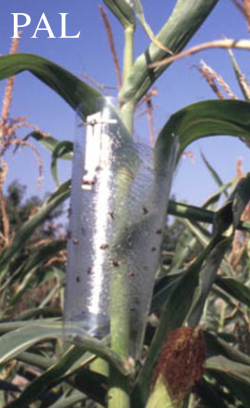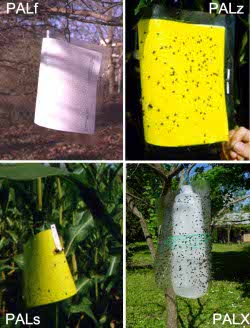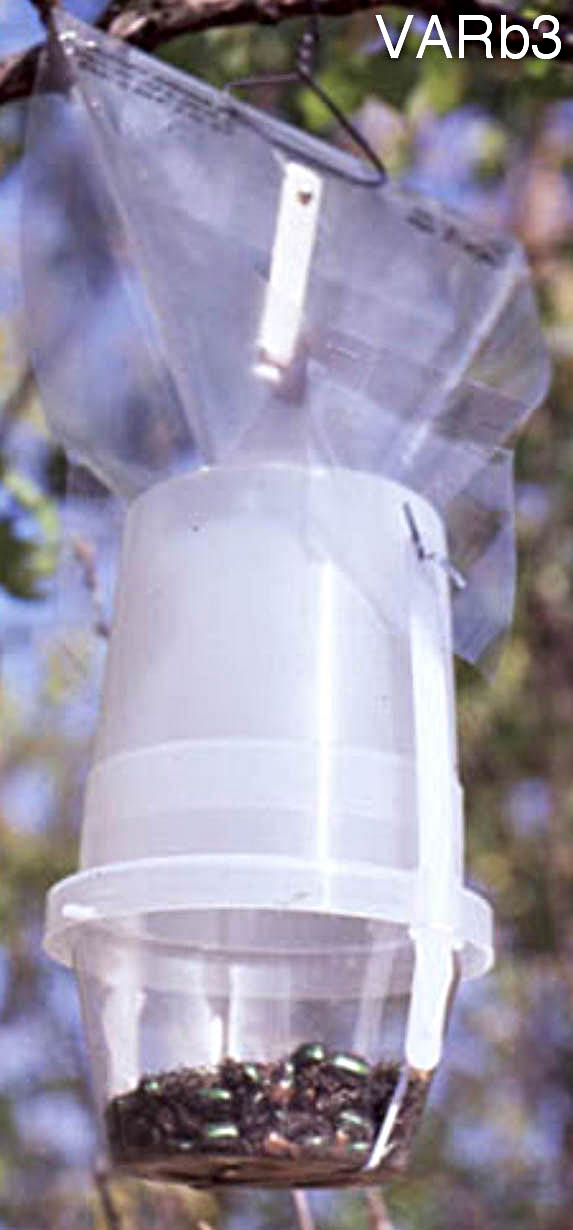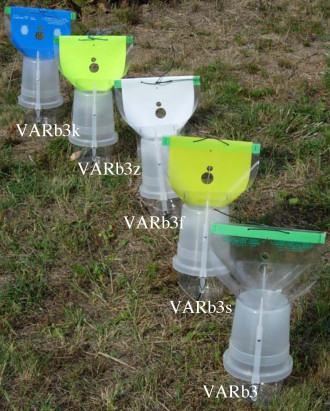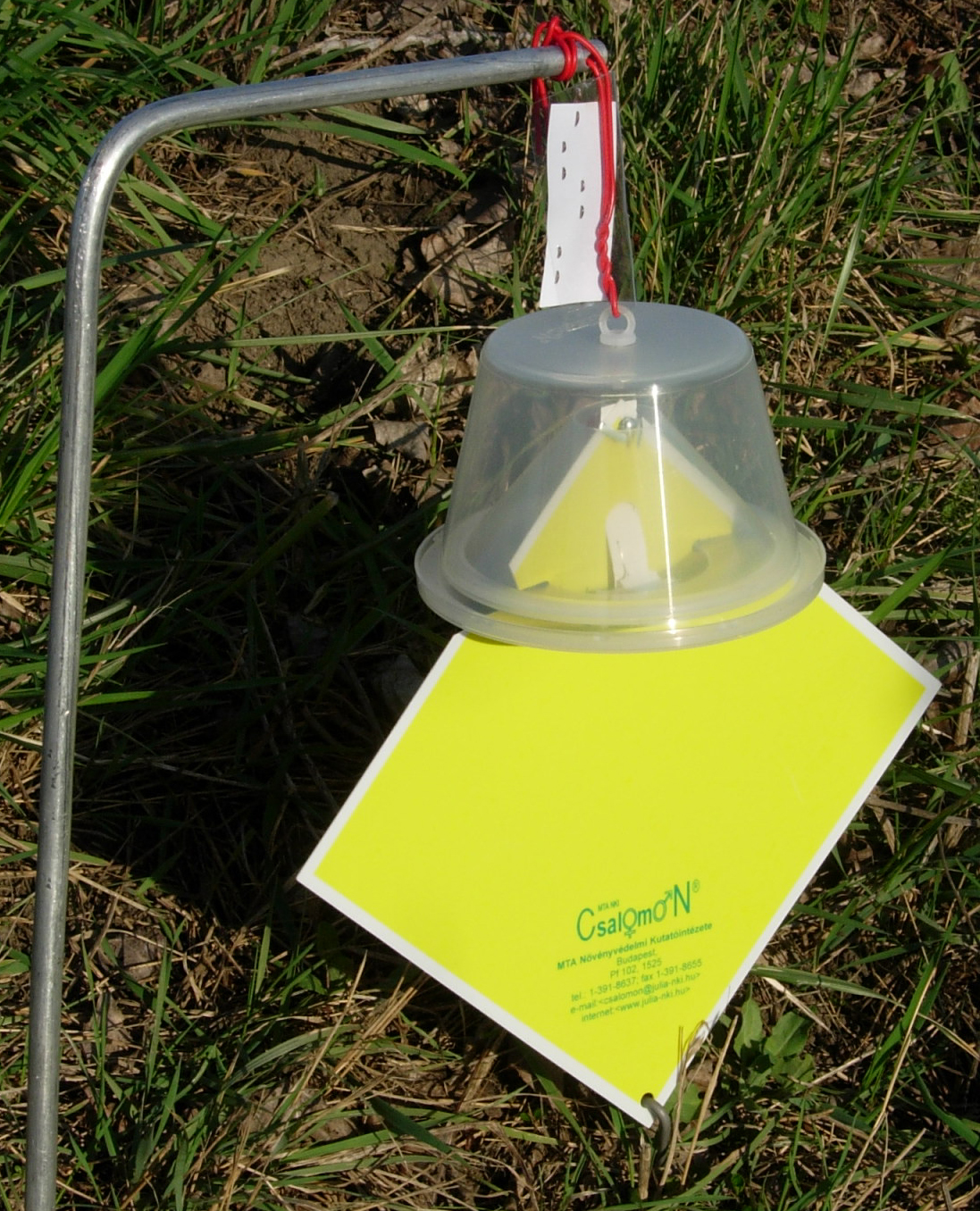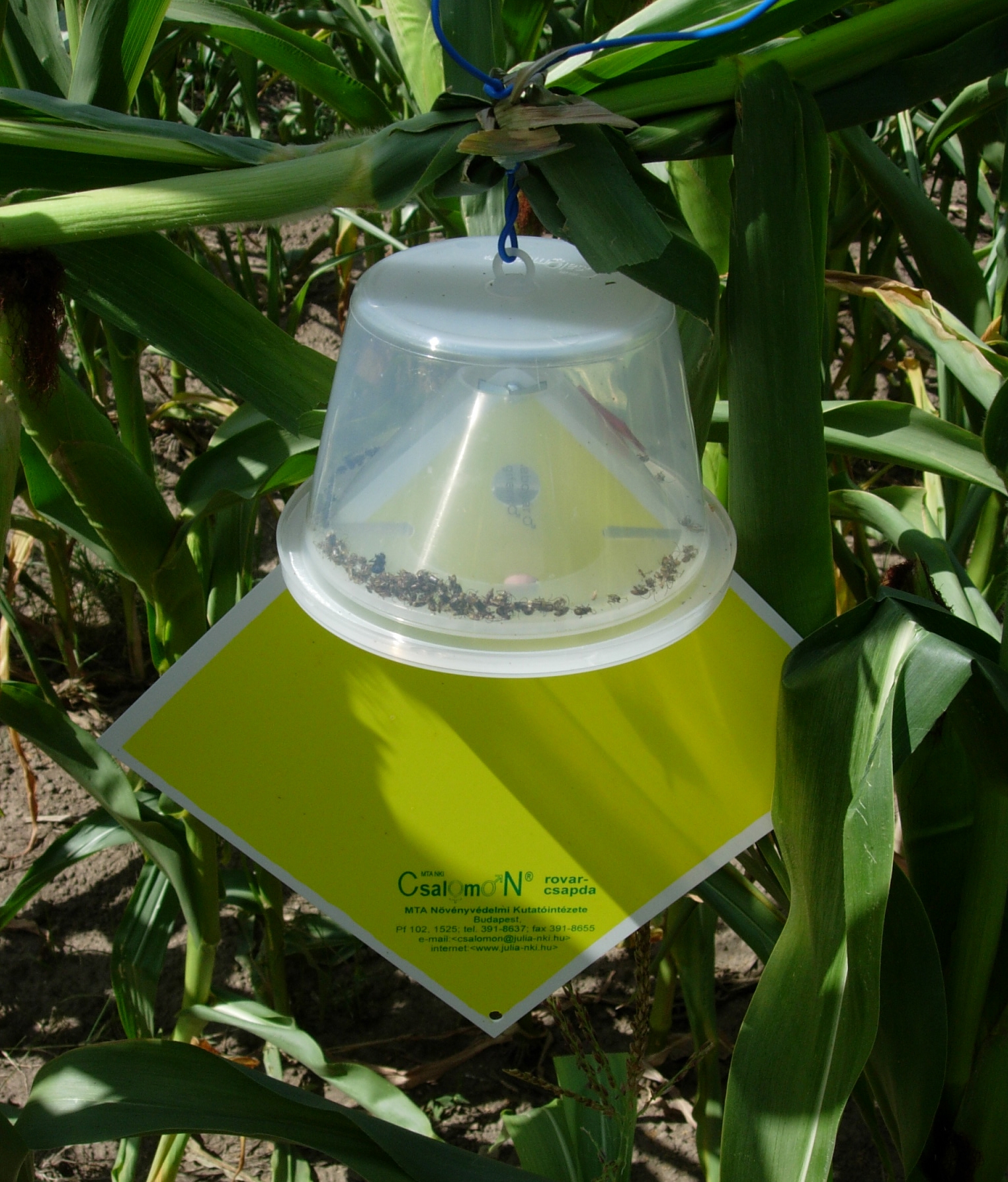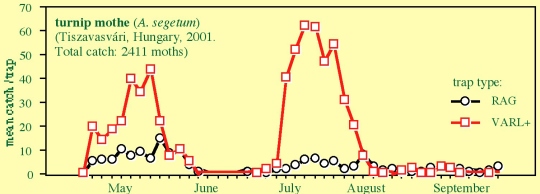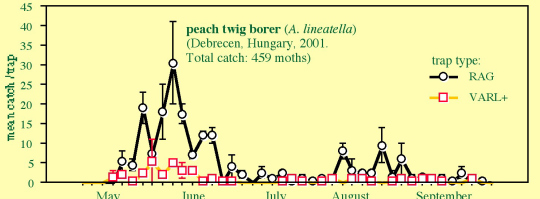
It catches the approaching insects on changeable sticky sheets. In the field it can be operated during 1 flight period (for 4 - 6 weeks) with the accessories included. This design is recommended for early detection. It is highly sensitive and detects the very first pest specimens appearing. Maintenance: change of sticky sheet each 7-10 days (may become necessary more often in case of high insect catches).
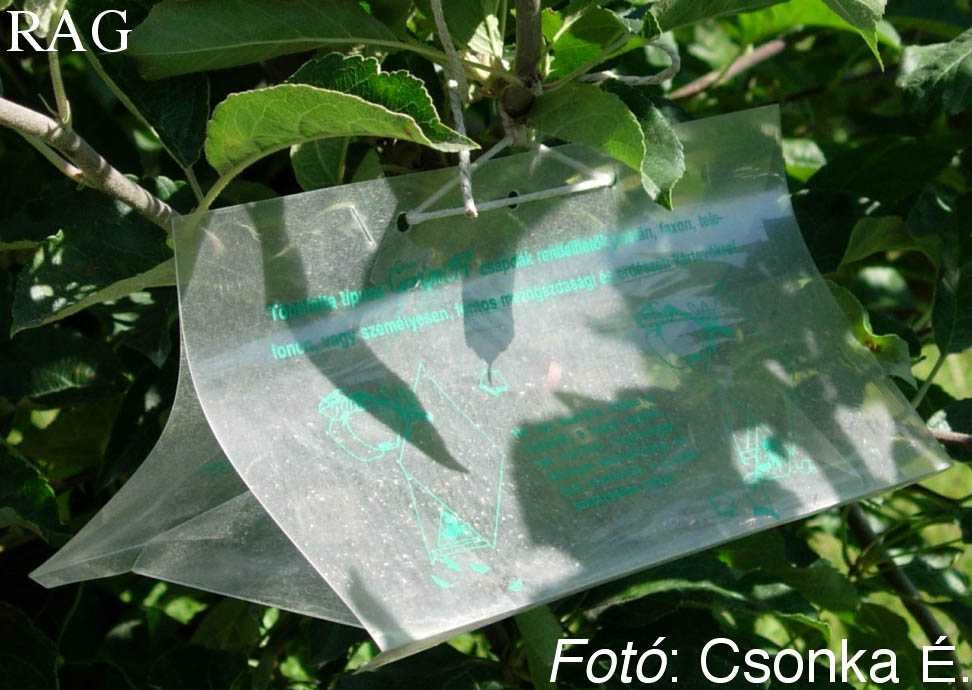
- sticky "cloak" trap (PAL=transparent, PALs=yellow, PALz= fluorescent yellow, PALf=white, PALX=for trapping Xyleborus dispar)
- It catches the approaching insects on its sticky surface. In the field it can be operated during 1 flight period (for 4 - 6 weeks) with the accessories included. This design is recommended for trapping pests which are reluctant to enter the sticky delta trap design, i.e. PAL or PALs for the western corn rootworm (Diabrotica v. virgifera ), PALz for the cherry fruit fly (Rhagoletis cerasi ), PALf for Hoplocampa spp. , etc (pls consult recommended trap type for each species in our lists) Maintenance: change of sticky sheet may become necessary if
funnel trap (VARL)
Insects approaching fall through a funnel into a catch container. In the
field it can be operated during 1 flight period (for 4-6 weeks) with the
accessories included. The useful life of the trap can be prolonged to
even a full season by regular exchange of the bait to a new one. However,
the trap can be used to catch ONLY the SAME SPECIES as before! This
design is recommended for catching large amounts of insects. It is
especially suitable for catching larger moths (Noctuidae,
Cossidae
, etc.) In contrast to sticky designs, it does not
loose efficiency when applied in dusty areas (mills, stores).
Maintenance: replacing the bait each 4-6 weeks. The trap has high
catching capacity; its efficiency is retained even when catching very
large numbers of insects. In some pests catch efficiency can be
significantly increased insects caught are killed in the catch container.
In selected cases it can be used for population control through mass
trapping.
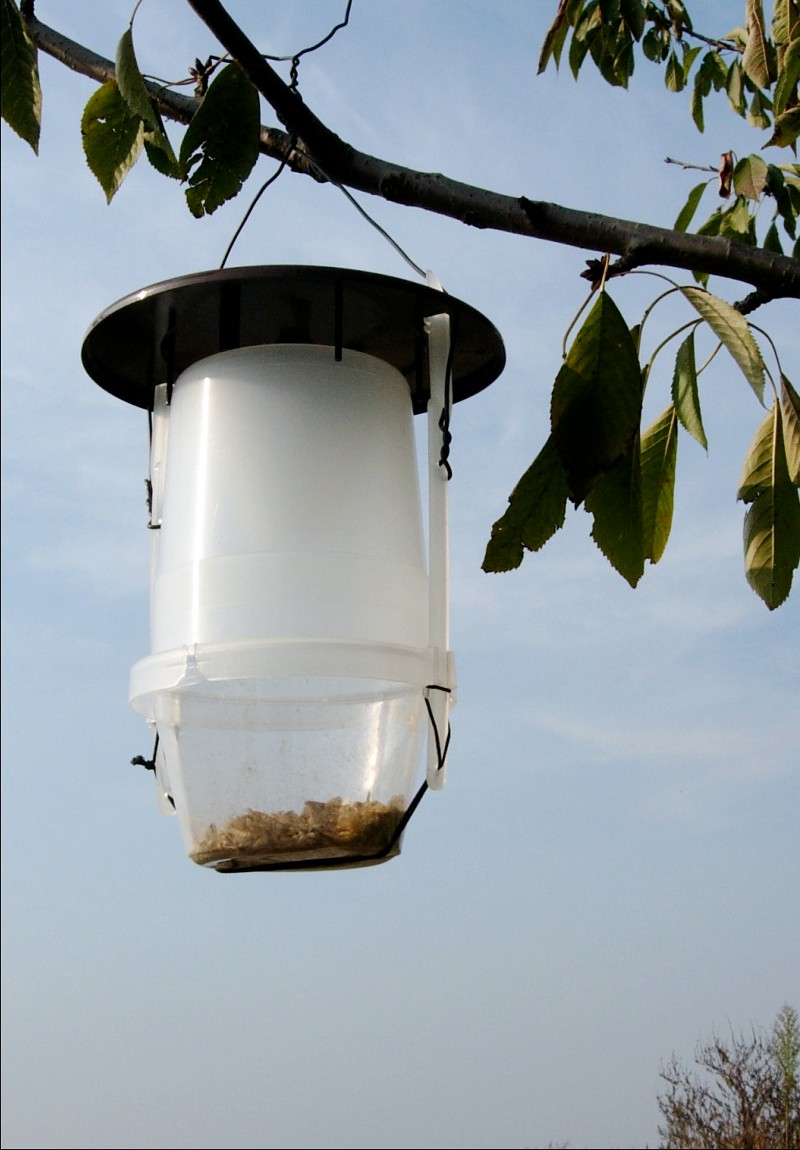
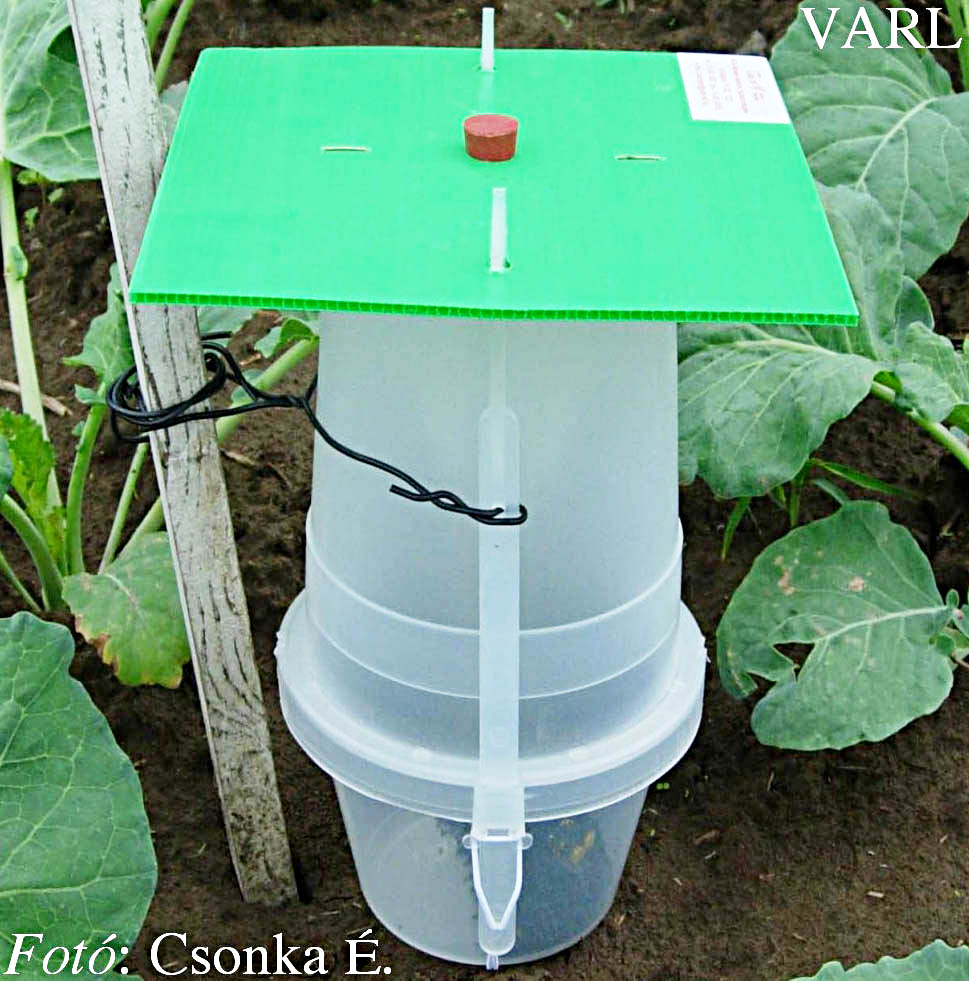
modified funnel trap
(VARb3,VARb3k,VARb3z)
Insects approaching fall through a funnel into a catch container. In the
field it can be operated during 1 flight period (for 4-6 weeks) with the
accessories included. The useful life of the trap can be prolonged to
even a full season by regular exchange of the bait to a new one. However,
the trap can be used to catch ONLY the SAME SPECIES as before!
This design is recommended for catching large amounts of insects. It is especially suitable for catching pests which are not so good fliers, i.e. the scarabs Anomala vitis, A. dubia, and Epicometis (Tropinota) hirta [VARb3k], the goat moth (Cossus cossus ) and several click beetles ( Agriotes spp. ). In contrast to sticky designs, it does not loose efficiency even when very large numbers are caught. Maintenance: replacing the bait each 4-6 weeks. The trap has high catching capacity; its efficiency is retained even when catching very large numbers of insects. In some pests catch efficiency can be significantly increased insects caught are killed in the catch container. In selected cases it can be used for population control through mass trapping. VARb3 variations by different colours can be used for pests with colour preference (coded by first letter of colours in Hungarian: VARb3k = blue, VARb3z = fluoresc. yellow, VARb3 f= white, VARb3s = yellow; pls refer to our list of products for optimal trap for given pest).
modified funnel trap (VARs+)
Insects attracted to the bait will move upwards and get into the upper
catch container, or they fall through a funnel into the lower catch
container. In the field it can be operated during 1 flight period (for
4-6 weeks) with the accessories included. The useful life of the trap
can be prolonged to even a full season by regular exchange of the bait
to a new one. However, the trap can be used to catch ONLY the SAME
SPECIES as before! This design can be recommended for catching large
amounts of insects. This trap design has been optimized for pests which
cannot be trapped efficiently with the more conventional funnel designs.
It is especially suitable for catching the corn rootworm (Diabrotica
v. virgifera), clearwing moths (Synanthedon
myopaeformis, S. tipuliformis), and the
gipsy moth (Lymantria dispar).
In contrast to sticky designs, it does not loose efficiency even when
very large numbers are caught. Maintenance: replacing the bait each 4-6
weeks. The trap has high catching capacity; its efficiency is retained
even when catching very large numbers of insects. For acceptable
efficiency it is necessary to kill the insects caught in both the upper
AND lower catch containers!).
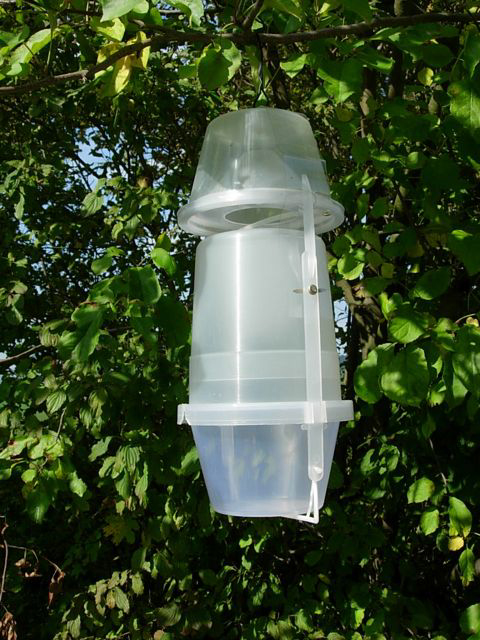
"hat" trap (KLP)
The insects attracted crawl up along the vertical plate and get into the
catch container. In the field it can be operated during 1 flight period
(for 4-6 weeks) with the accessories included. The useful life of the
trap can be prolonged to even a full season by regular exchange of the
bait to a new one. However, the trap can be used to catch ONLY the SAME
SPECIES as before! This design is especially suitable for the western
corn rootworm (Diabrotica v.
virgifera). (KLPfero+: with pheromone
bait; KLPflor+: with floral bait), or for flea beetles (
Phyllotreta spp.). In contrast to
sticky designs, it does not loose efficiency even when very large
numbers are caught. For acceptable efficiency it is necessary to kill
the insects caught in the catch container.
pitfall trap (TAL)
Insects crawling into the trap fall down into the catch container. In
the field it can be operated during 1 flight period (for 4-6 weeks) with
the accessories included. This design is recommended for catching
insects which predominantly crawl on the soil, i.e. the sugar-beet
veewil Bothynoderes (Cleonus)
punctiventris.
Maintenance: replacing the bait each 4-6 weeks. The trap has high
catching capacity; its efficiency is retained even when catching very
large numbers of insects. In selected cases it can be used for
population control through mass trapping.
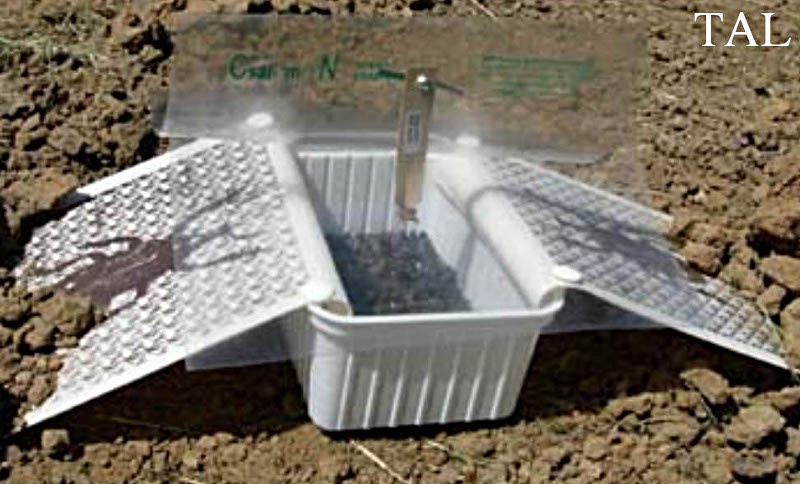
Click
beetle trap (Yf=YATLORf)
The plastic trap is the product of RO-SA Micromecanica s.a.s., Italy. We
supply the trap with species selective pheromone bait. The trap is
capable of catching both flying and crawling beetles. In the field it
can be operated during 1 flight period (for 4-6 weeks) with the
accessories included. The useful life of the trap can be prolonged to
even a full season by regular exchange of the bait to a new one. However,
the trap can be used to catch ONLY the SAME SPECIES as before! This
design is especially suitable for catching
Agriotes
spp.
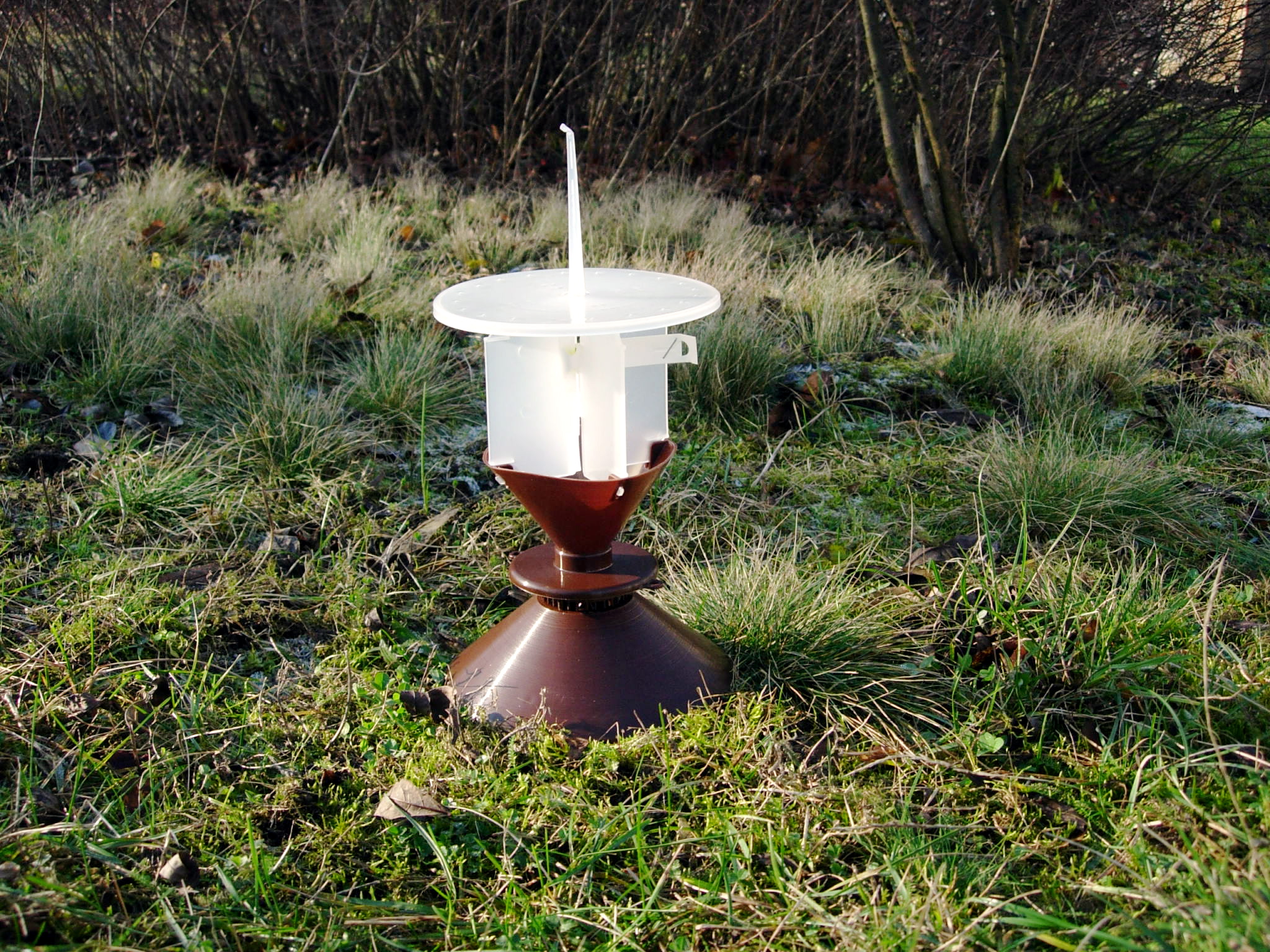
yellow/blue combined sticky trap (SZINb)
Insects are attracted to the bright colour; it contains no pheromone. It
catches the approaching insects on its sticky surface. In the field it
can be operated during 1 flight period (for 4 - 6 weeks) with the
accessories included. This design is recommended for trapping pests for
which no pheromonal lure is available, especially in greenhouses. It
proved to be excellent for catching the whitefly (Trialeurodes
vaporariorum; on the yellow part) and
the western flower thrips (Frankliniella
occidentalis; on the blue part).
Maintenance: change of sticky sheet may become necessary if many insects
are caught.
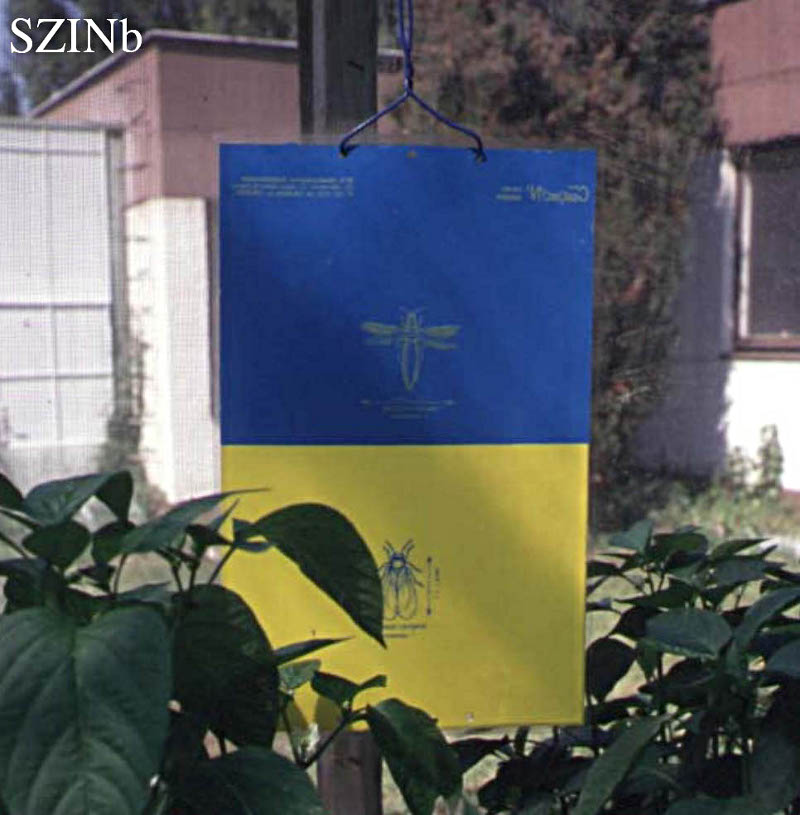
Coloured sticky traps (SZs= yellow, SZz= fluorescent yellow, SZf= white)
Insects are attracted to the bright colour; it contains no pheromone. It catches the approaching insects on its sticky surface. In the field it can be operated during 1 flight period (for 4 - 6 weeks) with the accessories included. This design is recommended for trapping pests for which no pheromonal lure is available, especially in greenhouses. The SZs (yellow) trap proved to be excellent for catching among others the whitefly (Trialeurodes vaporariorum) or aphids (Aphis spp.). The SZz (fluorescent yellow) trap catches best i.e. the grape thrips (Drepanothrips reuteri) or the onion thrips (Thrips tabaci). Greatest number of C. pruni was caught on white SZf sticky traps. Maintenance: change of sticky sheet may become necessary if many insects are caught.

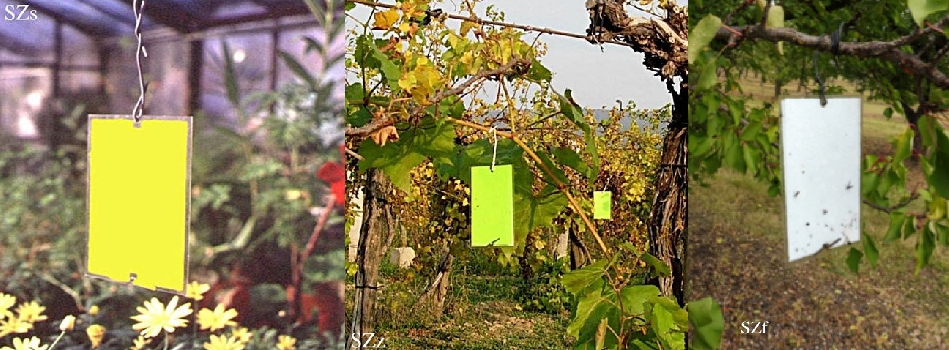
CHRegg lacewing egg concentrator
Lacewings attracted will lay their eggs on the surface of the device. After hatching lacewing larvae (in numbers magnitudes more than usual) will hunt for aphids on or near the plant where the device is suspended. In the field it can be operated for 3-4 weeks with the accessories included. By changing the lure to a new one the device's useful life can be prolonged for a whole season or even for several years. This design is recommended for use if our aim is to concentrate large numbers of lacewing eggs to a required place. The synthetic lure will attract ONLY members of the Chrysoperla carnea species group, other lacewing spp. are NOT attracted.
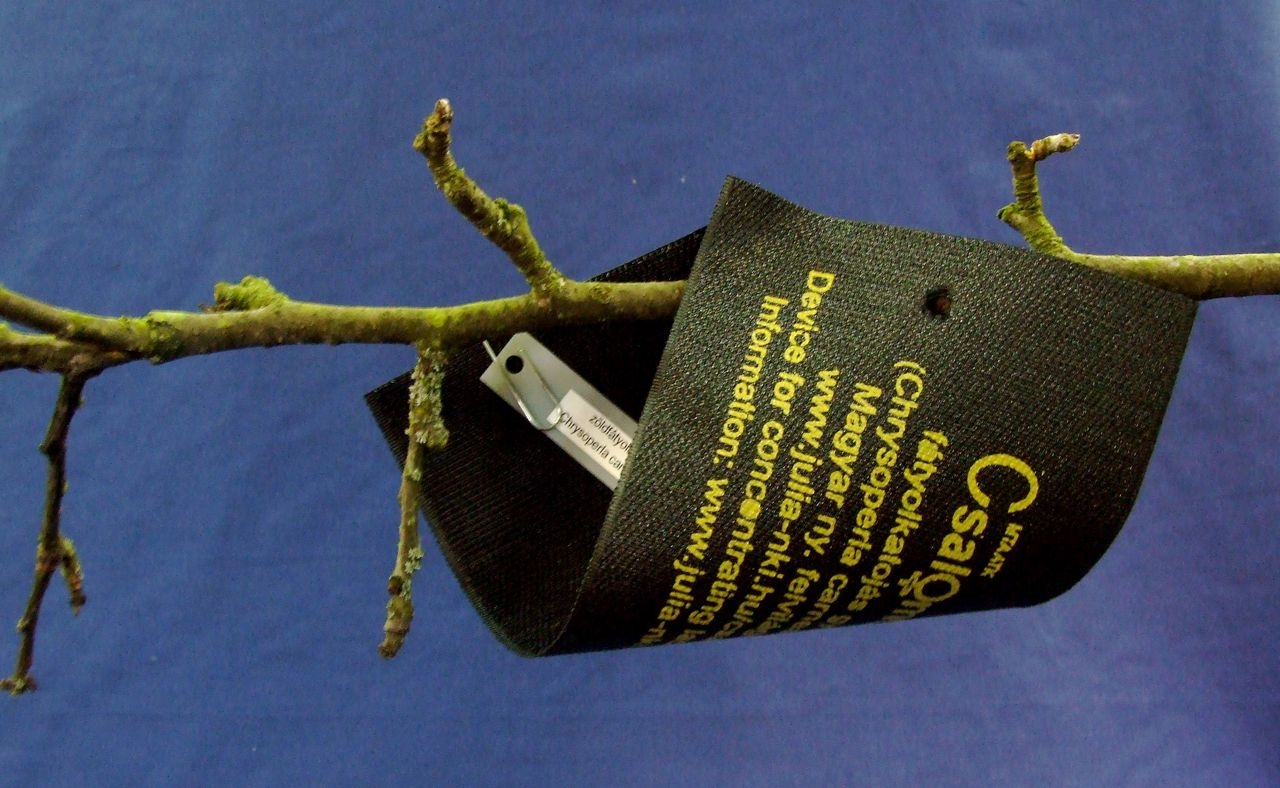
CO2 produced by germinating seeds in the attractant mixture will attract wireworms nearby into the catch container, where they can be counted. From the catch one can assess the population size of wireworms in the given plot. In the field the trap can be operated for 3-4 weeks with the accessories included. Trap parts are reusable, if one adds new attracant mixture. This design is recommended for use when in previous years on the given plot a large number of adult click beetles were caught in our pheromone traps (available from CSALOMON®), and before sowing we want to assess whether wireworm populations in our field do reach the damage threshold or not. A minimum of 10-15 traps should be applied for this purpose on a given plot. A trap will catch larvae of all economically important click beetle species.
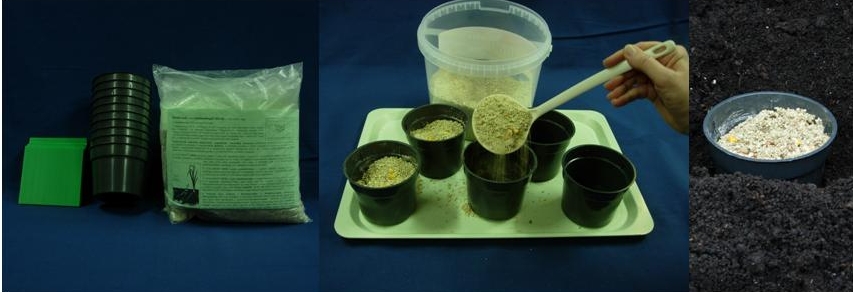
multifunnel trap (MULTz)
Agrilus spp. specimens are attracted to the MULTz trap by its light green (fluorescent yellow) colour even without any chemical baits, after which they fall through the coloured funnel system into the catch container.
In the field a trap can be operated for over 1-3 flight periods (1-3 x for 4-6 weeks). The trap life could be prolonged if collected from the field when not in use and stored at 10-30 °C in a shaded place, protected from sunlight.
Please use bait developed for your target species only - if available. Please note that non-optimized plant volatile baits may reduce catches!
MULTz trap was developed for catching jewel beetles (Buprestidae), but it is especially suitable for catching Agrilus spp., including the ash related A. planipennis (emerald ashborer or EAB) and A. convexicollis, further several oak related buprestids (A. obscuricollis, A. laticornis, A. graminis, A. angustulus, A. olivicolor, A. litura).
ATTENTION! Always place the trap to sunlit branches in the canopy. Choose the branches next to a road or an open area on the sunny side. Please use a curved metal wire mounted on a 5-7 meter pole (i.e. a carbon-fiber fishing stick) to reach branches at the height of 5-8 meters. Please see the Assembling instructions for the MULTz trap design for more details.
In contrast to sticky designs, MULTz does not loose efficiency even when large numbers are caught. Catch efficiency can be significantly increased, when insects caught are killed in the catch container. The addition of a small portion of a slow release formulation of a high vapour pressure insecticide into the catch container is optimal, but a spraying the inner surface of the catch container with a household insecticide might be sufficient. Instead of insecticides for alive catches the addition of host plant leaves is the best followed by regular inspections and renewal of the leaves (every second day).
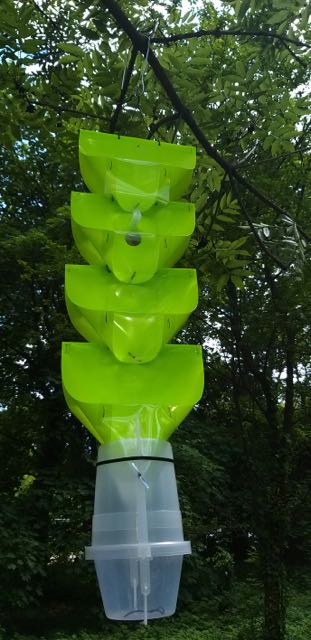
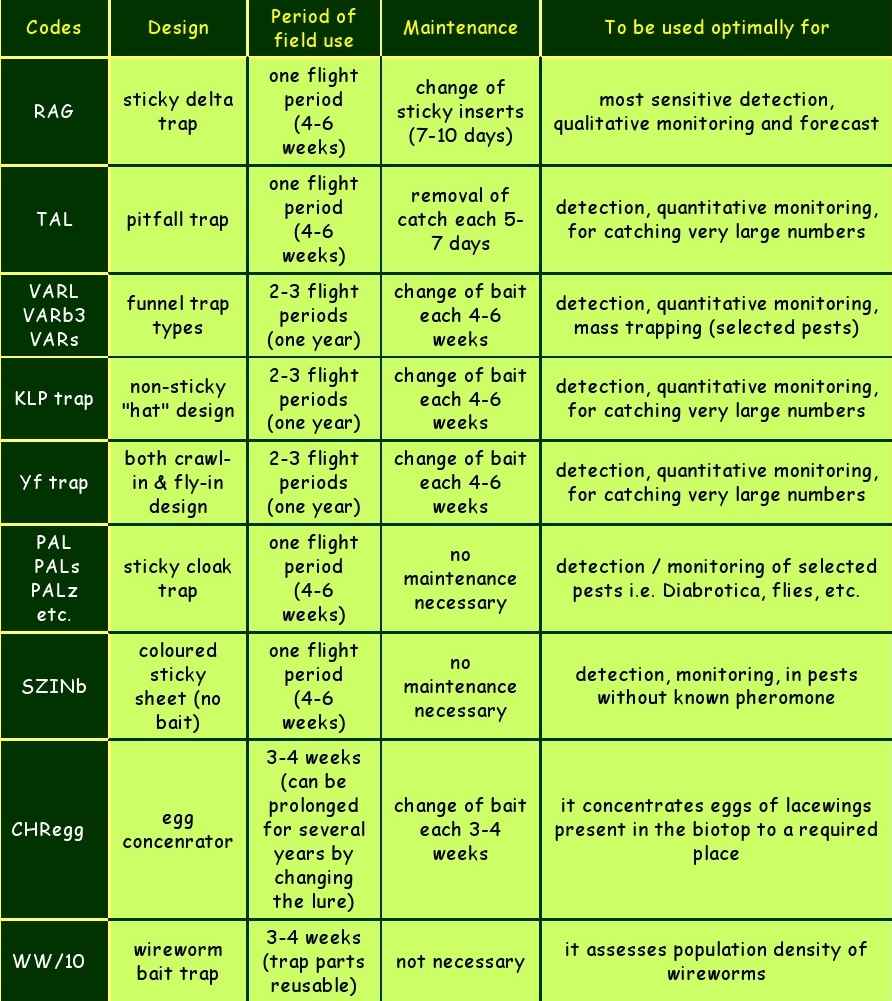
In moth pests the most frequently used trap design is the RAG (sticky delta), however, in case of larger species its catch capacity is very limited (because of the limited sticky surface area). In case of such pest species we can use RAG traps if our principal aim is the detection of occurrence only. If we are interested in monitoring the population changes throughout the flight (flight dynamics, mass outbreaks, any other quantitative aspects, etc.), it is more advisable to use a high capacity trap design (i.e. the funnel type VARL).
Attention! In case of funnel traps for pests where a "+" sign follows the trap code (i.e. VARL+), catch levels can be greatly increased if insects caught are killed in the container.
For best performance the shape of the trap should be optimized and also the presence of visual cue(s) (colour) may be required, which will enhance the activity of the chemical bait.
Without field testing it is impossible to foretell whether a given trap type is suitable for a given pest species or not. The trap types suggested for use with each pest in our List of Products have been exhaustively tested and optimized for the species in question. For best performance we recommend to use baits of a pest species EXCLUSIVELY in the trap type(s) recommended for that species in our List of Products!



